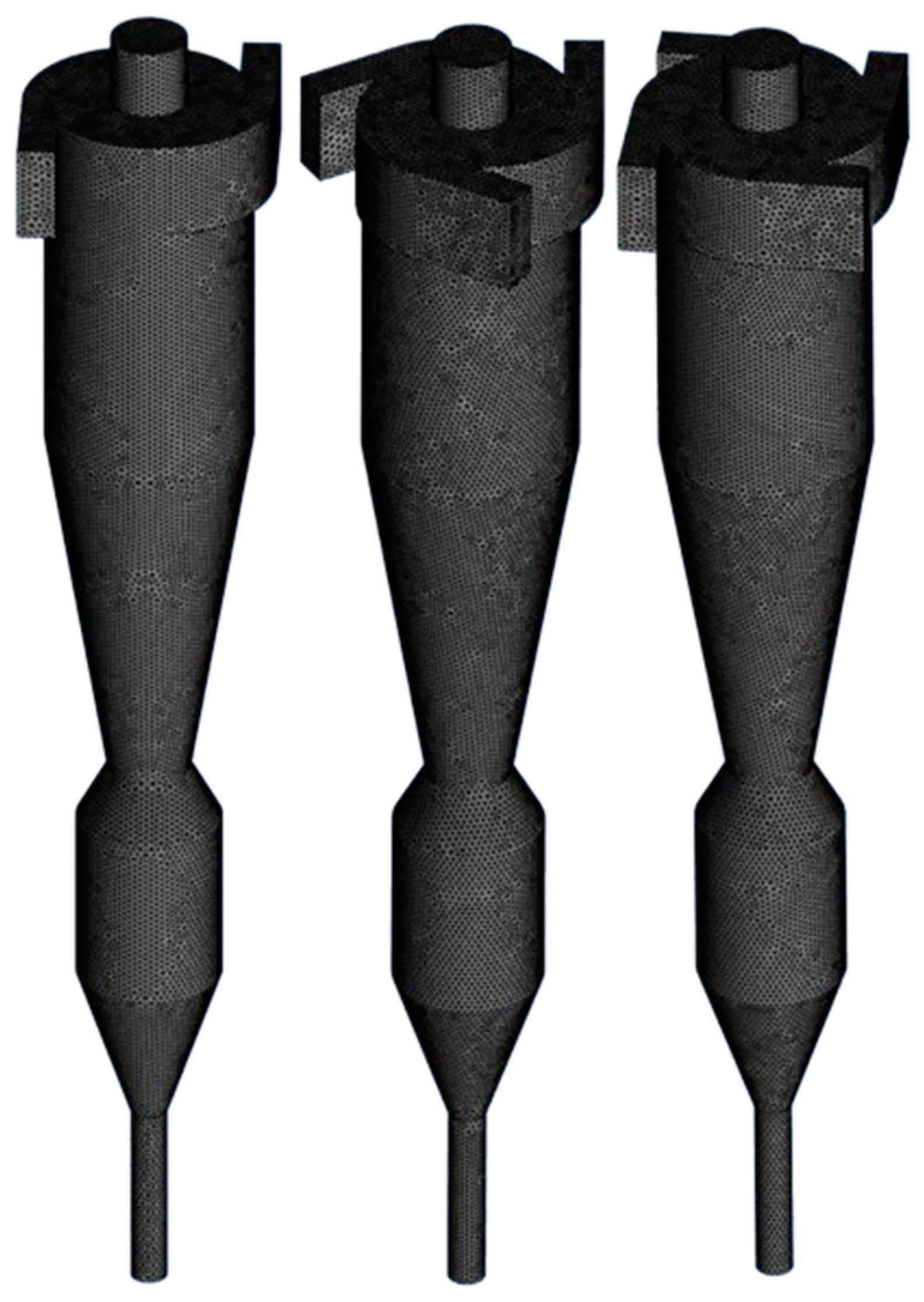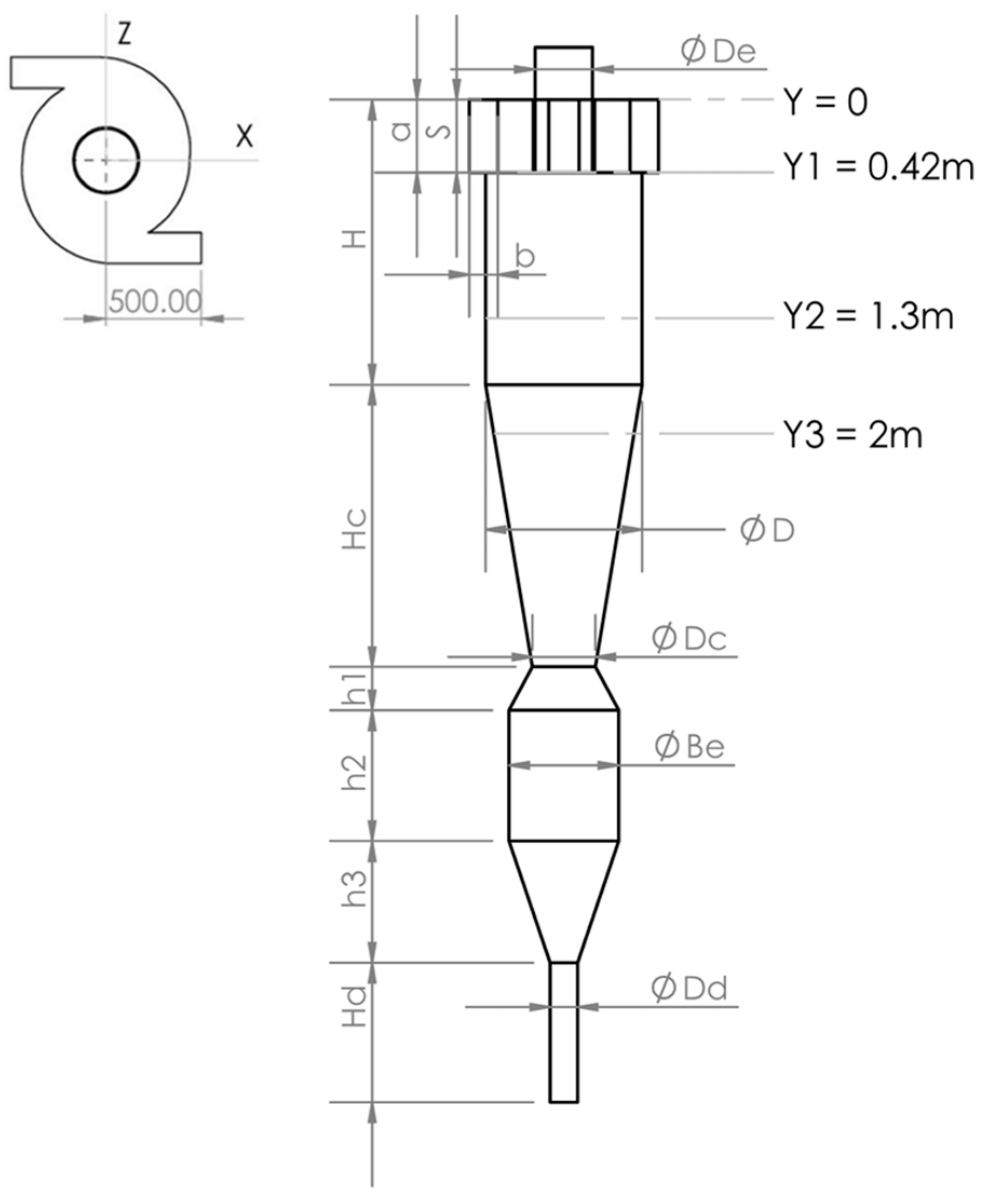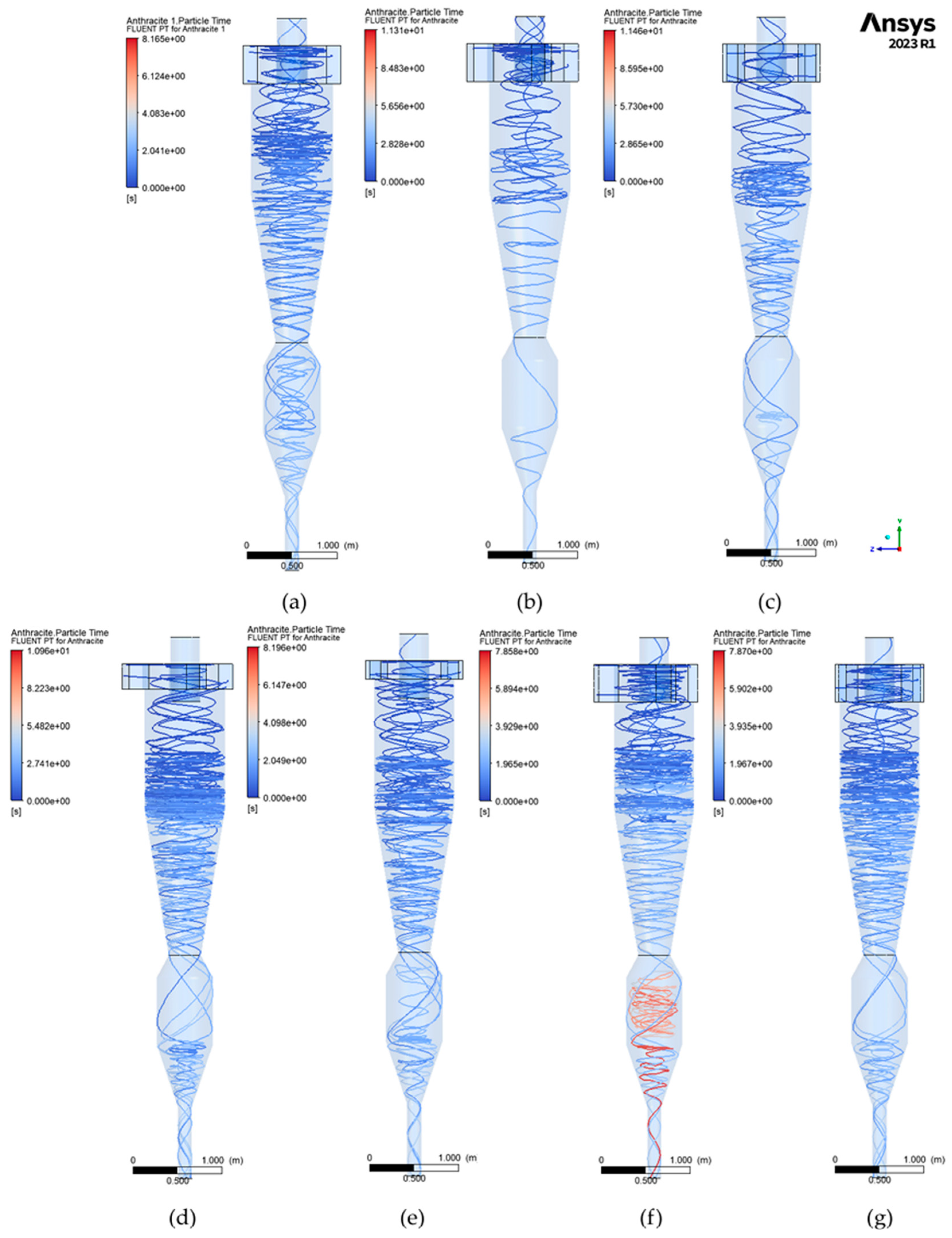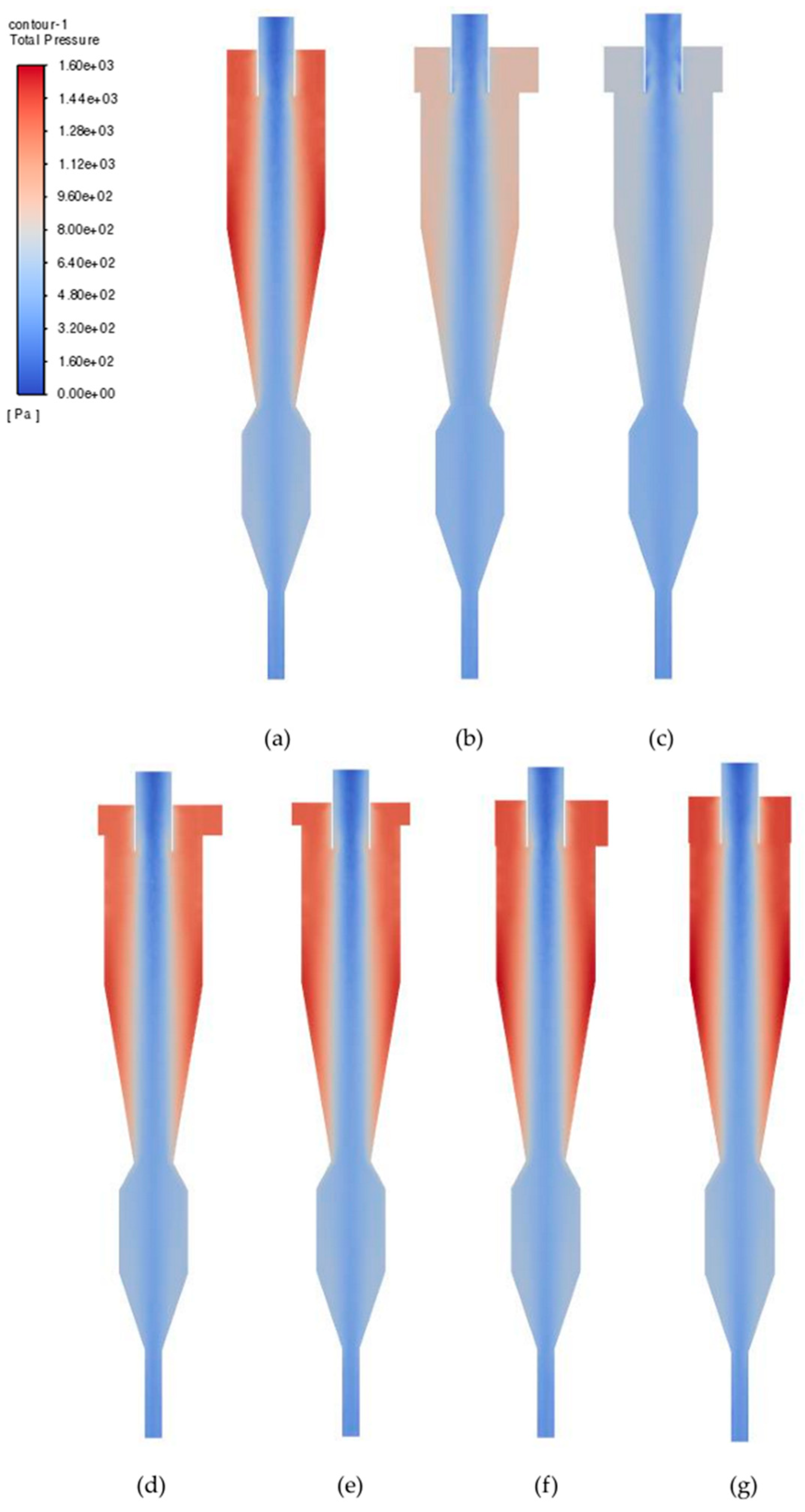Numerical Investigation of Inlet Height and Width Variations on Separation Performance and Pressure Drop of Multi-Inlet Cyclone Separators
Abstract
:1. Introduction
2. Methodology
2.1. Turbulence Model
- is the fluid density,
- ui is the velocity component in the i direction,
- μ is the molecular viscosity,
- μt is the turbulent viscosity,
- σk is the Prandtl number for the turbulent kinetic energy,
- Pk represents the production of turbulent kinetic energy,
- ε is the turbulent dissipation rate.
- is the additional variable introduced by the RNG model,
- The terms involving are responsible for improving the model’s performance, particularly in adverse pressure gradient flows.
2.2. Grid Independency Test
2.3. Validation of Numerical Setup
- = Number of particles trapped
- = Number of particles incomplete
- = Number of particles injected
2.4. Boundary Conditions
- = fluid density
- = hydraulic diameter
- = velocity
- = kinematic viscosity
3. Results
3.1. Collection Efficiency
3.2. Pressure Drop
3.3. Tangential Velocity
3.4. Axial Velocity
3.5. Turbulent Kinetic Energy, Dissipation Rate, and Intensity
4. Conclusions
- The 3i and 4i multi-inlet configurations performances were significantly lower relative to the baseline 2i. Changes in inlet height (a) and width (b) showed dramatic changes in performance, especially for the rectangular inlet configurations 3b and 4b, whose efficiency increased by 1.4% and 4.1% at 1.22 m3/s.
- The study revealed that altering inlet geometries to square or rectangular shapes increased tangential velocities. The 3a and 4a designs, featuring squared inlets, achieved lower tangential velocities comparable to the two-inlet design. In contrast, the 3b and 4b designs surpassed the baseline 2i cyclone separator, with average increases of 1.1% and 4.01% across all three axial positions.
- Higher downward axial velocities in cyclone separators generally enhance collection efficiency. However, increased short-circuit flow can disrupt the vortex pattern, leading to a reduction in axial velocity and, subsequently, a decrease in overall separation efficiency.
- Despite the enhancements in collection efficiency, the multi-inlet cyclones 3a, 3b, 4a, and 4b did not exhibit a significant increase in pressure drop. Specifically, 3a and 4a showed improvements of 3.1% and 1.2%, respectively, while 3b and 4b experienced only modest increases of 1.9% and 3.6% compared to the 2i cyclone.
- This research demonstrates that the separation efficiency of multi-inlet configurations is significantly influenced by turbulence. As the turbulence intensity in separators 3b and 4b increased to 6.25% and 6.53%, respectively, the separation efficiency improved by 0.3% to 0.5% compared to the base configuration 2i at a flow rate of 2.05 m³/s.
Author Contributions
Funding
Data Availability Statement
Conflicts of Interest
References
- Wasilewski, M.; Brar, L.S.; Ligus, G. Experimental and numerical investigation on the performance of square cyclones with different vortex finder configurations. Sep. Purif. Technol. 2020, 239, 116588. [Google Scholar] [CrossRef]
- Marinuc, M.; Rus, F. The effect of particle size and input velocity on cyclone separation process. Bull. Transilv. Univ. Brasov. For. Wood Ind. Agric. Food Eng. Ser. II 2011, 4, 117. [Google Scholar]
- Malahayati, N.; Darmadi, D.; Alisa Putri, C.; Mairiza, L.; Rinaldi, W.; Yunardi, Y. Comparative performance analysis between conventional and square cyclones for solid Particle-Gas Separation: A review. Mater. Today Proc. 2022, 63, S318–S325. [Google Scholar] [CrossRef]
- Brar, L.S.; Rahmani, F.; Wasilewski, M. Performance analysis of multi-inlet cyclone separators considering different shapes and locations of the inlet ducts. Adv. Powder Technol. 2024, 35, 104325. [Google Scholar] [CrossRef]
- Elsayed, K.; Lacor, C. The effect of cyclone inlet dimensions on the flow pattern and performance. Appl. Math. Model. 2011, 35, 1952–1968. [Google Scholar] [CrossRef]
- E, D.; Fan, H.; Su, Z.; Xu, G.; Zou, R.; Yu, A.; Kuang, S. Numerical study of the multiphase flows and separation performance of hydrocyclone with tapered cross-section inlet. Powder Technol. 2023, 416, 118208. [Google Scholar] [CrossRef]
- Fetuga, I.A.; Olakoyejo, O.T.; Abolarin, S.M.; Adelaja, A.O.; Ologunoba, S.O.; Oluwatusin, O.; Fetuata, O.; Adewumi, O.O.; Robinson, U.D.; De Oliveira Siqueira, A.M. Eulerian–Lagrangian fluid dynamics study on the effects of inlet radial angle on the performance and flow pattern of multi-inlet cyclone separator. Alex. Eng. J. 2023, 78, 453–468. [Google Scholar] [CrossRef]
- Chen, J.; Jiang, Z.; Chen, J. Effect of inlet air volumetric flow rate on the performance of a Two-Stage cyclone separator. ACS Omega 2018, 3, 13219–13226. [Google Scholar] [CrossRef]
- Parvaz, F.; Hosseini, S.H.; Elsayed, K.; Ahmadi, G. Numerical investigation of effects of inner cone on flow field, performance and erosion rate of cyclone separators. Sep. Purif. Technol. 2018, 201, 223–237. [Google Scholar] [CrossRef]
- Prasanna, N.; Subramanian, K.; Ajay, S.; Rajagopal, T.; Vigneshwaran, V. CFD study on the performance of reducing pressure drop holes in cyclone separator. Mater. Today Proc. 2021, 43, 1960–1968. [Google Scholar] [CrossRef]
- Movafaghian, S.; Jaua-Marturet, J.A.; Mohan, R.S.; Shoham, O.; Kouba, G.E. The effects of geometry, fluid properties and pressure on the hydrodynamics of gas–liquid cylindrical cyclone separators. Int. J. Multiph. Flow 2000, 26, 999–1018. [Google Scholar] [CrossRef]
- Wang, Z.; Sun, G.; Jiao, Y. Experimental study of large-scale single and double inlet cyclone separators with two types of vortex finder. Chem. Eng. Process. 2020, 158, 108188. [Google Scholar] [CrossRef]
- Safikhani, H.; Zamani, J.; Musa, M. Numerical study of flow field in new design cyclone separators with one, two and three tangential inlets. Adv. Powder Technol. 2018, 29, 611–622. [Google Scholar] [CrossRef]
- Kuang, S.; Chu, K.; Yu, A.; Vince, A. Numerical study of liquid–gas–solid flow in classifying hydrocyclones: Effect of feed solids concentration. Miner. Eng. 2012, 31, 17–31. [Google Scholar] [CrossRef]
- Cyclone Separator Working Principle (Dust Separator) Explained—saVRee. (n.d.). Available online: https://savree.com/en/encyclopedia/cyclone-separator-working-principle-dust-separator (accessed on 1 June 2024).
- Dong, S.; Wang, C.; Zhang, Z.; Cai, Q.; Dong, K.; Cheng, T.; Wang, B. Numerical study of short-circuiting flow and particles in a gas cyclone. Particuology 2023, 72, 81–93. [Google Scholar] [CrossRef]
- Huang, A.N.; Ito, K.; Fukasawa, T.; Fukui, K.; Kuo, H.P. Effects of particle mass loading on the hydrodynamics and separation efficiency of a cyclone separator. J. Taiwan Inst. Chem. Eng. 2018, 90, 61–67. [Google Scholar] [CrossRef]
- Ostermeier, P.; Fischer, F.; Fendt, S.; DeYoung, S.; Spliethoff, H. Coarse-grained CFD-DEM simulation of biomass gasification in a fluidized bed reactor. Fuel 2019, 255, 115790. [Google Scholar] [CrossRef]
- Han, C.; Hu, Y.; Li, W.; Bie, Q. Gas-solid separation performance and structure optimization in 3D printed guide vane cyclone separator. Adv. Powder Technol. 2022, 33, 103815. [Google Scholar] [CrossRef]
- Yao, Y.; Shang, M.; Huang, Z.; Zhou, T.; Zhang, M.; Yang, H.; Lyu, J. Effects of the inlet duct length on the performance of a dense medium cyclone: An experimental and numerical study. Chem. Eng. Res. Des. 2022, 187, 41–50. [Google Scholar] [CrossRef]
- Zhang, L.; Fan, J.; Zhang, P.; Gao, F.; Chen, G.; Li, J. Effect of local erosion on the flow field and separation performance of the cyclone separator. Powder Technol. 2023, 413, 118007. [Google Scholar] [CrossRef]
- Sun, Y.; Yu, J.; Wang, W.; Yang, S.; Hu, X.; Feng, J. Design of vortex finder structure for decreasing the pressure drop of a cyclone separator. Korean J. Chem. Eng. 2020, 37, 743–754. [Google Scholar] [CrossRef]
- Chen, J.; Shi, M. A universal model to calculate cyclone pressure drop. Powder Technol. 2007, 171, 184–191. [Google Scholar] [CrossRef]
- Analytis, G. Implementation and assessment of the renormalization group (RNG), quadratic and cubic non-linear eddy viscosity k–ε models in GOTHIC. Nucl. Eng. Des. 2001, 210, 177–191. [Google Scholar] [CrossRef]
- Perini, F.; Zha, K.; Busch, S.; Reitz, R. Comparison of Linear, Non-Linear and Generalized RNG-Based k-Epsilon Models for Turbulent Diesel Engine Flows, SAE Technical Papers on CD-ROM/SAE Technical Paper Series. [CrossRef]
- Papageorgakis, G.C.; Assanis, D.N. Comparison of linear and nonlinear RNG-based k-epsilon models for incompressible turbulent flows. Numer. Heat Transf. Part B Fundam. 1999, 35, 1–22. [Google Scholar] [CrossRef]
- Barua, S.; Batcha, M.F.M.; Amin, A.M.; Mohammed, A.N.; Wae-Hayee, M. Optimizing Cyclone Separator Performance: Effects of Vortex Finder Diameter, Inlet Velocity, and Particle Diameter on Separation Efficiency and Pressure Drop. J. Adv. Res. Appl. Mech. 2024. under publication. [Google Scholar]
- Wang, Z.; Sun, G.; Song, Z.; Yuan, S.; Qian, Z. Effect of inlet volute wrap angle on the flow field and performance of double inlet gas cyclones. Particuology 2023, 77, 29–36. [Google Scholar] [CrossRef]
- Wei, Q.; Sun, G.; Gao, C. Numerical analysis of axial gas flow in cyclone separators with different vortex finder diameters and inlet dimensions. Powder Technol. 2020, 369, 321–333. [Google Scholar] [CrossRef]
- E, D.; Xu, G.; Fan, H.; Cui, J.; Tan, C.; Zhang, Y.; Zou, R.; Kuang, S.; Yu, A. Numerical investigation of hydrocyclone inlet configurations for improving separation performance. Powder Technol. 2024, 434, 119384. [Google Scholar] [CrossRef]
- 2003. In Handbook of Fluidization and Fluid-Particle Systems; CRC Press eBooks: Boca Raton, FL, USA. [CrossRef]
- Song, J.; Sun, G.; Chao, Z.; Wei, Y.; Shi, M. Gas flow behavior and residence time distribution in a FCC disengager vessel with different coupling configurations between two-stage separators. Powder Technol. 2010, 201, 258–265. [Google Scholar] [CrossRef]
- Karagoz, I.; Avci, A. Modelling of the pressure drop in tangential inlet cyclone separators. Aerosol Sci. Technol. 2005, 39, 857–865. [Google Scholar] [CrossRef]
- Feng, M.; Gui, C.; Zhou, Y.; Lei, Z. Numerical study on performance optimization and flow mechanism of a new cyclone separator. Green Chem. Eng. 2024, in press. [Google Scholar] [CrossRef]
- Chaghakaboodi, H.A.; Saidi, M. Numerical study of gas-solid flow in a square cyclone separator with different vortex finders. Process Saf. Environ. Prot. 2023, 194, 621–635. [Google Scholar] [CrossRef]
- Seon, G.; Ahn, J.; Hwang, W. Analysis of the impact of flow characteristics on the separation efficiency and pressure drop of a cyclone-type oil separator. J. Mech. Sci. Technol. 2022, 36, 273–283. [Google Scholar] [CrossRef]
- Wang, C.; Ma, Y.; Sui, W. The Secondary Flows in a Cyclone Separator: A review. Processes 2023, 11, 2935. [Google Scholar] [CrossRef]
- Misiulia, D.; Lidén, G.; Antonyuk, S. Secondary lip flow in a cyclone separator. Flow Turbul. Combust. 2023, 110, 581–600. [Google Scholar] [CrossRef]
- Yang, H.; Wang, N.; Cao, Y.; Meng, X.; Yao, L. Effects of helical fins on the performance of a cyclone separator: A numerical study. Adv. Powder Technol. 2023, 34, 103929. [Google Scholar] [CrossRef]




















| Size (mm) | Element | Pressure-Drop (Pa) | Y—Velocity (m/s) |
|---|---|---|---|
| 40 | 176,018 | 1038.154 | 24.71 |
| 35 | 240,098 | 1101.714 | 24.81 |
| 30 | 342,952 | 1162.353 | 24.84 |
| 27 | 440,281 | 1210.44 | 24.85 |
| 25 | 528,379 | 1246.695 | 24.86 |
| Geometry | Cyclone | Dimension |
|---|---|---|
| Barrel diameter, D/mm | 900 | |
| Vortex finder diameter, De/mm | 330 | |
| Vortex finder length, S/mm | 419 | |
| Vortex finder length (Outer), mm | 300 | |
| Inlet height, a/mm | 2i, 3i, 4i, 3b, 4b | 419 |
| 3a | 279.3 | |
| 4a | 209.5 | |
| Inlet width, b/mm | 2i, 3i, 4i, 3a, 4a | 163 |
| 3b | 108.7 | |
| 4b | 81.5 | |
| Inlet length, mm | 500 | |
| Barrel height, H/mm | 1638 | |
| Cone height, Hc/mm | 1620 | |
| Cone bottom diameter, Dc/mm | 360 | |
| Bin diameter, Be/mm | 630 | |
| Dipleg diameter, Dd/mm | 156 | |
| Dipleg length Hd (mm) | 800 | |
| h1 (mm), h2 (mm), h3 (mm) | 250, 750, 700 |
| Particle Diameter | Wang et al. [28] | Barua et al. [27] | Deviation (%) | Average (Approx) |
|---|---|---|---|---|
| 1 | 50.64 | 53.64 | 3 | 2% |
| 5 | 74.35 | 76.24 | 1.89 | |
| 7 | 93.37 | 88.61 | 4.76 | |
| 10 | 100 | 98.35 | 1.65 | |
| 12 | 100 | 99.34 | 0.66 | |
| 20 | 100 | 100 | 0 |
| Item | Value | Unit |
|---|---|---|
| Flowrate | 1.22, 1.63, and 2.05 | /s |
| Particle diameter | 1 to 20 | µm |
| Particle bulk density | 1750 | kg/ |
| Type | Cyclone Separator | |||
|---|---|---|---|---|
| Inlet | 2i | 3.6% | 3.5% | 3.4% |
| 3i | 3.82% | 3.68% | 3.58% | |
| 4i | 3.9% | 3.82% | 3.72% | |
| 3a and 3b | 3.77% | 3.64% | 3.54% | |
| 4a and 4b | 3.63% | 3.5% | 3.41% | |
| Outlet | 2i, 3i, 4i, 3a, 3b, 4a, and 4b | 3.88% | 3.75% | 3.36% |
| Cyclone Type | /s | /s | /s |
|---|---|---|---|
| 2 inlet | 26.1% | 26.3% | 26.8% |
| 3 inlet | 28.0% | 28.1% | 28.6% |
| 4 inlet | 46.2% | 28.1% | 28.6% |
| 3 inlet a | 26.7% | 27.0% | 27.4% |
| 4 inlet a | 25.7% | 26.0% | 26.5% |
| 3 inlet b | 29.1% | 29.1% | 29.6% |
| 4 inlet b | 26.1% | 26.4% | 26.9% |
Disclaimer/Publisher’s Note: The statements, opinions and data contained in all publications are solely those of the individual author(s) and contributor(s) and not of MDPI and/or the editor(s). MDPI and/or the editor(s) disclaim responsibility for any injury to people or property resulting from any ideas, methods, instructions or products referred to in the content. |
© 2024 by the authors. Licensee MDPI, Basel, Switzerland. This article is an open access article distributed under the terms and conditions of the Creative Commons Attribution (CC BY) license (https://creativecommons.org/licenses/by/4.0/).
Share and Cite
Barua, S.; Batcha, M.F.M.; Mohammed, A.N.; Saif, Y.; Al-Alimi, S.; Al-fakih, M.A.M.; Zhou, W. Numerical Investigation of Inlet Height and Width Variations on Separation Performance and Pressure Drop of Multi-Inlet Cyclone Separators. Processes 2024, 12, 1820. https://doi.org/10.3390/pr12091820
Barua S, Batcha MFM, Mohammed AN, Saif Y, Al-Alimi S, Al-fakih MAM, Zhou W. Numerical Investigation of Inlet Height and Width Variations on Separation Performance and Pressure Drop of Multi-Inlet Cyclone Separators. Processes. 2024; 12(9):1820. https://doi.org/10.3390/pr12091820
Chicago/Turabian StyleBarua, Saikat, Mohd Faizal Mohideen Batcha, Akmal Nizam Mohammed, Yazid Saif, Sami Al-Alimi, Mohammed A. M. Al-fakih, and Wenbin Zhou. 2024. "Numerical Investigation of Inlet Height and Width Variations on Separation Performance and Pressure Drop of Multi-Inlet Cyclone Separators" Processes 12, no. 9: 1820. https://doi.org/10.3390/pr12091820





